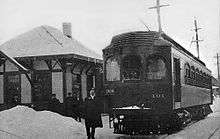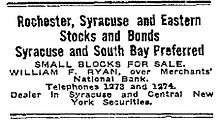Rochester, Syracuse and Eastern Rapid Railroad
| Locale | Rochester, New York to Syracuse, New York |
|---|---|
| Dates of operation | 1906–1917 |
| Successor | Rochester and Syracuse Railroad |
| Track gauge | 4 ft 8 1⁄2 in (1,435 mm) standard gauge |
The Rochester, Syracuse and Eastern Railroad, an interurban rail, began operations in 1906 and linked Rochester, New York, with the nearby towns of Newark, Egypt, Fairport and Palmyra. At its peak the railroad was 87 miles (140 km) in length and employed steel catenary bridges over much of the line to support the trolley wire. [1] The railroad was owned by the Beebe Syndicate, and was the only one of its properties that was designed and constructed by the management group.
History

The rail was part of the Beebe Syndicate, a group of 12 high-speed, interurban, electric train lines which ran from Buffalo, New York, through Rochester and Syracuse, then north to Oswego on Lake Ontario. The Rochester, Syracuse and Eastern Railroad (RS&E) portion ran from downtown Rochester to Auburn through East Rochester, Fairport, Palmyra, Newark, among others.[2]
The tracks paralleled the New York Central Railroad and the Erie Canal and had only one grade crossing with another railroad its entire length.[3]
The consent to build was granted by the New York State Board of Railroad commissioners on September 1, 1902. By 1907, the road operated from Rochester to Clyde and the work to Port Byron was well underway[4]
Company management
During March 1905, the company, headed by Lyman C. Smith of Syracuse, and C. T. Beebe, general manager, announced the expected completion of the portion of the road between Rochester and Lyons, a distance of 36 miles (58 km), as ready for operation by January 1, 1906. The plans for the construction work involved the expenditure of more than $2,000,000. More than 1,000 men were hired to complete the construction. The object of the project was to unite Syracuse and Rochester with a double-tracked railroad upon which electric cars would be driven at a rate of 70 miles per hour (110 km/h).[5]


The towns and cities touched by this railroad were Brighton, Despatch, Fairport, Egypt, Macedon, Palmyra, Newark, Lyons, Clyde, Savannah, Port Byron, Weedsport, Jordan, Memphis, Warners, Amboy, Belle Isle and Syracuse. With a few exceptions, the road was built on public right of way.[5]
Four bridges between Palmyra and Rochester were ordered from the Owego Bridge Company and several more were in the works. They were the most "approved style" in use on interurban roads and cost from $10,500 to $12,000 each.[5]

Company expansion
By June 1910, the company had completed plans for the construction of shops and buildings including four standard stations at Lyons, Newark, Fairport and Brighton. The waiting room was designed to have a seating capacity of 35 persons and the freight section was 50 feet (15 m) by 20 feet (6.1 m). Both sections were estimated to cost $16,000 each and would be completed later in the year.[6]
At the same time, an announcement was made that the rail had added a new link connecting Syracuse to Port Byron.[6]
The Rochester, Syracuse and Eastern Railroad crossed Wayne County and Cayuga County in New York State and terminated at Lake Shore Junction at New York State Fairgrounds in Onondaga County. In Wayne County, Route 31 occupied the former bed.[7]
Financial problems
The RS&E cost $144,000 per mile to build which was significantly more than an average railroad and never made a profit in its 25-year history. It failed to prosper for several reasons. The main reason for failure occurred because the road competed with an existing steam railroad and was never able to garner enough lucrative freight business. The initial construction cost was too great for its earning capacity. Additionally, like all interurbans, the road lost out to competition from the gasoline engine, as automobiles became the transportation mode of choice.[2]
Construction costs amounted to $7 million, an exceptionally large sum in 1909. In 1913, largely in an effort to deal with heavy fixed charges of the Rochester, Syracuse and Eastern Railroad, Beebe merged the line with two of his other interurban rails.[3]
Empire United Railways (1913-1916)

Financial issues in 1913 forced the company to merge with two nearby interurbans; the Auburn and Northern Electric Railroad and the Syracuse, Lake Shore and Northern Railroad forming the Empire United Railways.[2]
The effort was not successful and the new company failed in 1915 and was dissolved into its individual component interurbans in 1916.[3]
Rochester and Syracuse Railroad (1917-1931)
Beebe withdrew from interurban operation and the road was reorganized in 1917 as the Rochester and Syracuse Railroad[3] which remained in operation until 1931 when it was abandoned.[8] Starting in 1928, the Rochester Subway was used to access downtown Rochester through a connection at Winton Road. After 1928, a local commuter service between Fairport and Culver Road continued to operate on the surface tracks via University Avenue. The last trolley run on the line took place June 27, 1931.[9]
Land Use After Abandonment
By 1974, Niagara Mohawk and New York State Electric and Gas Company had power lines on the railbed in Cayuga County and in Onondaga County the bed was occupied by Niagara Mohawk as a power line and pipeline right-of-way and the easterly 2 miles (3.2 km) were occupied by Mobil Oil Company pipeline.[7] Today, the property formerly occupied by the railroad is part of the Perinton Hike-Bikeway trail in Rochester, New York.[2]
References
- ↑ Middleton, William (1961). The Interurban Era. Kalmbach. p. 97. LCCN 61-10728. Retrieved 18 April 2016.
- 1 2 3 4 "Perinton Hike-Bikeway". Foot Print Press, Inc., 2011. Retrieved March 5, 2011.
- 1 2 3 4 Hilton, George Woodman; Due, John Fitzgerald (1960). The Electric Interurban Railways in America. Stanford University Press. p. 314. Retrieved March 4, 2011.
- ↑ Beauchamp, Rev. William Martin. "Past and present of Syracuse and Onondaga county, New York (Volume 1)". New York: S. J. Clarke Publishing Co., 1908. Retrieved January 14, 2012.
- 1 2 3 "36 Miles Ready by 1 January Next". The Post-Standard. Syracuse, New York. March 6, 1905.
- 1 2 Electric railway journal, Volume 35. McGraw Publishing Company, New York, New York, June 1910 p. 764. Retrieved February 19, 2011.
- 1 2 "Inventory of Abandoned Railroad Rights of Way". New York State Department of Transportation, 1974. Retrieved February 18, 2011.
- ↑ "New York Interurbans and Streetcar Railroads". American-rails.com, 2007-2011. Retrieved February 17, 2011.
- ↑ TravElectric - The Story of the Rochester, Syracuse & Eastern Railroad and Associated Lines, by James R. McFarlane; published by the Central Electric Railfans Association, copyrighted 2010